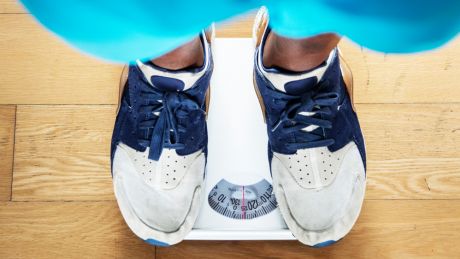Running For Weight Loss: An Expert Explains All
What do you need to know if you’re running to lose weight? We asked an expert

Running is one of the easiest activities to support weight loss. There’s no complicated new exercises to learn or expensive pieces of equipment to invest in. It’s essentially stepping out of the front door and going for a walk – just a bit faster.
But while running can certainly help you lose weight, there are pitfalls that can be dispiriting – unless you take steps to avoid them. To get the maximum benefit of running when losing weight you need to ensure that you’re doing it in the right way. To understand this we asked Dr Justin Roberts from Anglia Ruskin University’s Cambridge Centre for Sport and Exercise Sciences for guidance on how best to go about running for weight loss.
Below you’ll find his complete answers on the best way to go about this, but first, a few key takeaways from the interview:
- If you’re new to running, don’t dive in with high-intensity runs from the start. Begin with slower runs, or “fatmax” training.
- Running in the morning can increase your metabolic rate and increase weight or fat loss later on in the day.
- Additional strength training can help build lean mass and prevent running injuries.
- Mix up your training with different types of run to avoid hitting a plateau – for example, do a long, slow run one day and intervals on another.
- Make sure you eat enough to support your running. If you’re aiming for a calorie deficit make sure it’s a minor one and that it comes from doing enough exercise, rather than reducing your food intake.
- Most runners need 1g to 1.4g of protein per kilo of body mass per day. If you’re strength training as well, that might increase to about 1.5 to 1.8g per kilo per day.
- Fasted running can help use your fat stores, but might not be sustainable if you’re doing high-intensity runs.
- Getting gait analysis can help you find shoes that are comfortable and fit well.
- A basic heart rate monitor can be a great way to monitor your training and the progress you’re making.
What sort of running routine is optimal for sustained weight loss?
We tend to burn less fat with high-intensity work, strictly speaking, but we burn more calories. If someone wants to lose weight, I would probably recommend lower intensities, but with high-intensity work – things like interval runs or tempo runs.
But if you’ve got someone who’s quite new to running, I wouldn’t throw them in a high-intensity programme from day one, I’d opt for a slower run – what we call fatmax training. Technically it is maximal fat oxidation and the intensity this occurs at is called the fatmax intensity, which can be correlated to heart rate. It will differ between people, with fitter people tending to have a higher fatmax.
I’d also think about when you run as well. There’s good evidence that running in the morning increases metabolic rate, and this might also link to increased weight loss or fat loss later on.
How do you know what your fatmax intensity is?
Fatmax is highly individual although typical ranges can occur within a particular cohort, so less fit people versus more fit people versus very fit people. Less fit individuals tend to have lower fatmax results, ie 0.1-0.3g/min at maybe 30-40% of VO2 max. Fitter individuals, particularly from an endurance exercise background, tend to be higher, ie 0.4-0.6g/min at say 55-70% VO2 max. However, there are many factors which can influence this.
Sign up for workout ideas, training advice, reviews of the latest gear and more.
From the studies we have conducted, most people’s fatmax occurs when the rate of perceived exertion is actually very low – two or three – and with a heart rate of about 115-130 (depending on the sport). However, it is important to stress this is very individual and influenced by a number of factors.
Should you just do fatmax training to lose weight?
Training at fatmax could optimise the amount of fat being used during exercise. However, it is important to note that at lower intensities, calorific yield would also be lower. Hence a combination of exercise types – interval training, HIIT training and fatmax training – could be beneficial.
Is running on its own enough, or do you need strength training to accompany it?
Many runners run with muscle imbalances or specific imbalances, so by strengthening the muscles around the joints, for example, this might improve the likelihood of running more efficiently and reduce the chance of developing injuries. Plus, if you’re gaining lean mass, this might also improve or have a positive influence on your metabolism.
How can people avoid plateauing?
Typically, I’ve found people hit a plateau because they’re just trying to do the same thing time and again. I think there’s a lot of sense in mixing up your training – so a long, slow and steady run one day, and intervals or hill runs on another, for example.
When I try to understand someone’s plateau, often it’s because they haven’t set a training goal. So the first thing is to maybe look at the goal and whether it’s challenging.
What sort of diet would help you have enough strength to complete runs while still losing weight?
This is a tough one, because it depends on a number of factors. If someone’s trying to lose weight, the assumption is that they’re going to be doing some sort of negative balance diet so their calories in are lower than their calories out – eating slightly less or maybe exercising a bit more. But one of the big problems I’ve found working with runners in particular is when they’re not eating enough to fuel their training.
So there’s a conundrum here because, yes, if you eat less food, you’re reducing your calories and creating that negative balance, which might then lead to weight reduction – but you may not have enough energy to sustain lots of training over multiple days. So I would say it’s about making sure that any deficit is a minor one, and that it should come from the exercise, rather than reducing what you eat too much.
If you’re going to do resistance training as well, most of the research I’ve read talks about having a more balanced macronutrient split: something like 40 to 50% of your diet for carbohydrates, 20 to 30% protein and the rest in fat. There’s also a lot of evidence to suggest that most runners need somewhere between one and 1.4g of protein per kilo of body mass per day. If strength training is involved and we’re including some sort of calorie reduction, that might increase to about 1.5 to 1.8g per kilo per day.
See related
- Running For Beginners: Free Couch To 5K Plan
- What You Need To Know About Your Metabolism For Weight Loss
- 33 Running Tips To Help You Become A Better Runner
- 13 Expert Weight-Loss Tips
Is it worth trying fasted running if you’re trying to lose weight?
First of all, we need to define what fasted running means. If you run when you haven’t eaten for a long time, such as before breakfast, you’re tapping into your liver glycogen stores and part of your muscle glycogen stores, making the session more geared towards reverting to fat metabolism. So if you’re trying to encourage the body to utilise fat stores during exercise, training on an empty stomach in the morning has its advantages.
But I would also be conscious of what you’re trying to achieve here. If it’s pure weight loss and someone’s doing a fairly high-intensity programme, is it sustainable?
Is there any kit you’d recommend especially for overweight runners?
In our lab, once people have done their physical testing, we often recommend they see a running specialist and undergo a gait analysis to see which type of shoes would be beneficial for them. They must be comfortable and well-fitting. The rest of your gear comes down to personal preference, although it’s important to avoid chafing and make sure your clothing is breathable.
You don’t necessarily need all the fancy gadgets like GPS systems, but having a very basic heart rate monitor can be useful. If someone’s looking to see if they’re adapting to the training, one of the first signs you see is a reduction in the heart rate.
Some people struggle to lose weight just by running. Why might that be?
You have to look at the person and what they’re actually doing. I’ve had people come into the lab and say, “My weight seems to be the same, what’s going on?” What they’ve actually done is gained lean muscle – maybe they’ve lost half a kilo in weight and gained half a kilo in tissue, so the net loss is zero. It’s not that they haven’t made improvements, it’s just they’re not seeing it by simply measuring weight.
Other people may monitor their weight every day in the morning and say, “Well, I’m only shifting by 0.1 of a pound” – but they’re looking at it in a micro fashion and not seeing the bigger picture. So they probably are losing weight, but just not seeing it over a typical day.
When people weigh themselves is a factor as well. If I go for a typical run, which uses muscle glycogen, and then I consume carbohydrate to replace that muscle carbohydrate, that’s going to lead to an increase in weight as well.
You could also be drinking or eating more food without realising it. I remember one case where a client was eating quite healthily, but snacking throughout the day, and drinking things like lattes, which are calorie-dense.
Alan is a freelance tech journalist and mostly covers fitness trackers for Coach.
Alan was not what you would call a big fitness guy growing up, but has been radicalised by parkrun and taken up running in a big way. Although nowhere near podium at races, as a late starter he does at least know that he can still get faster. Alan has written for ShortList, Tom’s Guide, Trusted Reviews and Expert Reviews, among others.

